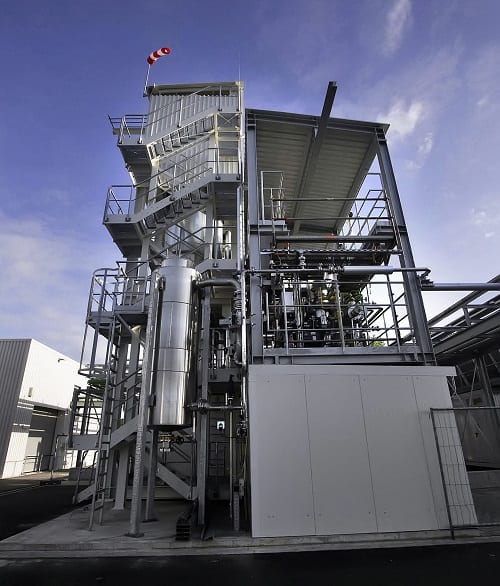Audi has opened an e-gas plant in Werlte, making it the first automobile manufacturer to develop a chain of sustainable energy carriers. It begins with green electricity, water and carbon dioxide. The end products are hydrogen and the synthetic methane: Audi e-gas.
“Audi is taking a giant step toward the mobility of the future today,” said Heinz Hollerweger, Head of Total Vehicle Development, in his speech at the inauguration. ‘Mobility of the future’ is an often heard expression, but the power-to-gas idea seems to be a viable option for energy storage.
 The power-to-gas facility – Audi calls it e-gas plant – works in two process steps: electrolysis and methanation. In the first step, the plant uses surplus green electricity to break water down into oxygen and hydrogen in three electrolyzers. The hydrogen could one day power fuel-cell vehicles. For the time being, however, in the absence of an area-wide infrastructure, a second process step is carried out directly: methanation. The hydrogen is reacted with CO2 to produce synthetic methane. It is virtually identical to fossil natural gas and will be distributed via an existing infrastructure, the German natural gas network, to the CNG filling stations. The plant is scheduled to begin feeding e-gas to the grid this fall.
The power-to-gas facility – Audi calls it e-gas plant – works in two process steps: electrolysis and methanation. In the first step, the plant uses surplus green electricity to break water down into oxygen and hydrogen in three electrolyzers. The hydrogen could one day power fuel-cell vehicles. For the time being, however, in the absence of an area-wide infrastructure, a second process step is carried out directly: methanation. The hydrogen is reacted with CO2 to produce synthetic methane. It is virtually identical to fossil natural gas and will be distributed via an existing infrastructure, the German natural gas network, to the CNG filling stations. The plant is scheduled to begin feeding e-gas to the grid this fall.
The power-to-gas plant will produce about 1,000 metric tons of e-gas per year, chemically binding some 2,800 metric tons of CO2. This roughly corresponds to the amount that a forest of over 220,000 beech trees absorbs in one year. Water and oxygen are the only by-products.
Automaker built the facility in collaboration with the plant construction specialist ETOGAS GmbH (formerly SolarFuel) and its project partner MT-BioMethan GmbH on a 4,100 m2 (44,132.03 sq ft) plot of land owned by EWE AG. Ground was broken in September 2012, and the topping-out ceremony was celebrated in December. The efficient use of energy flows is the top priority in the production sequence of the plant. The waste heat given off during methanation is used as process energy in the adjacent biogas plant, significantly increasing overall efficiency. In return, this plant supplies the highly concentrated CO2 required as a basic building block for the e-gas. This CO2 thus serves as a raw material and is not emitted to the atmosphere.
The power-to-gas project transcends the automobile industry. It shows how large amounts of green electricity can be stored efficiently and independently of location by transforming it into methane gas and storing it in the natural gas network, the largest public energy storage system in Germany.
The e-gas project is part a comprehensive e-fuels strategy. In parallel with the e-gas plant in Werlte, the company also operates a research facility in Hobbs, New Mexico, USA, for the production of e-ethanol and e-diesel in collaboration with Joule. At this facility, microorganisms use water (brackish, salt or wastewater) sunlight and carbon dioxide to produce high-purity fuels. The strategic goal of these projects is to use CO2 as a raw material for fuels and thus improve the overall footprint substantially.

















